In September 2020, organizers of Rio de Janeiro’s official carnival parade canceled the annual event, set for February 2021, leaving the nature of the carnival itself in flux. The parade will be back (like my travel plans), but no one knows when.
As it happens, I was in Rio in the fall of 2019, just as Cariocas were planning the 2020 version of their famed, and flashy, parade.
I joined a group visit to a samba school’s factory to get a firsthand look at parade preparations, try on fancy costumes and dance with a samba artist. The nonprofit Carnaval Experience operated the tour.
A dozen or more of the city’s samba schools (which are really clubs) prepare for the carnival parade at Samba City, a complex of warehouses where the groups have space to build several floats each.
During a September visit, we could see old floats and costumes, but nothing had yet been created for 2020. A visit closer to carnival time would have been more circumscribed because new floats and costumes are top secret until parade day.
Our guide said the schools, each with around 3,500 members, have professional planners who design the themes for the year. Themes, relying on new songs as well as visuals, may use allegory and satire to call out failings of society or the government. Parade themes are a way for slaves’ descendants to have a voice, our host said.
Funding comes from corporate and other sponsors. Tourists also help with funding when they pay to participate on the streets with a samba school.
After sightseeing and a film, our group was invited to don typical carnival costumes and pose for photos. We were joined by a samba dancer who demonstrated the dance, then invited tour members to join.
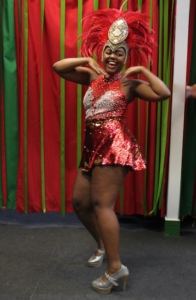
A dancer demonstrates the samba for tourists visiting the Samba City complex in Rio de Janeiro.
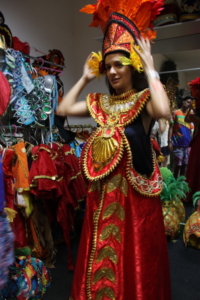
Manoela Barcellos, public relations manager in Brazil for the Marriott group, tries on a typical carnival costume during our visit to Samba City.
We were offered drinks after the tour. I skipped the caipirinha, the national cocktail. Its main ingredient, cachaca or distilled sugarcane juice, is 40% alcohol.
Olympic preparation
Brazil invested heavily preparing its most famous carnival town for the 2016 Olympics, producing a lasting payoff for locals and post-Games visitors like me. The city, and the rest of us, gained an upgraded transport infrastructure, a rejuvenated port district and all-new attractions.
One of those new attractions, in the port district, is the fantastic (my opinion) “Ethnicities,” the world’s largest spray paint mural by a team, measuring 560 feet by 51 feet (28,560 square feet), numbers that landed this artwork in the Guinness Book of World Records.
Positioned on the side of an abandoned warehouse with rough and very imperfect bricks for a painting surface, “Ethnicities” features oversized renditions of five indigenous faces, plus maps of the continents. The five faces are each based an indigenous group hailing from one of the five continents depicted in the mural.
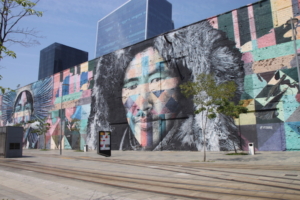
A look at about 40% of the 560-foot-long “Ethnicities” mural. The figure in the foreground, a Supi man, represents Europe.
I could name the origins of two people fairly easily — for Oceania, a man from Papua New Guinea and, for Asia, a Karen woman from either Burma (aka Myanmar), or Thailand where Karen people were living in refugee camps when I visited.
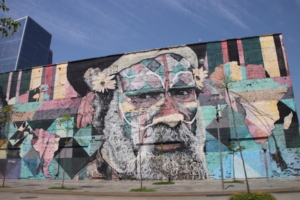
Above, a Huli man from Papua New Guinea, representing Oceania on the “Ethnicities” mural, and below, a Karen woman, representing Asia.
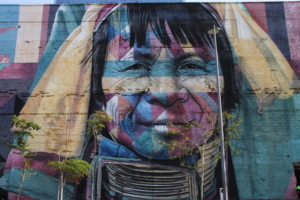
The other three were, for Africa, an Ethiopian woman; for Europe, an Arctic man, and, for the Americas, a boy from Brazil’s Amazon region.
Located on the port district’s Olympic Boulevard, the entire production is exotic, grand and exceedingly colorful.
“Ethnicities” is one of three new attractions planned for the port district in the run-up to the Olympics, and the three are in walking distance of one another. I talked about the other two, AquaRio and the Museum of Tomorrow, here: https://besttripchoices.com/brazil-beyond-burning-forests/
The rest, truncated
This has gotten too long really fast. Everything else will be truncated. My Rio visit also included the following — except for the soccer stadium part.
First, the old standbys, Sugarloaf Mountain (including a very impressive cable car ride) and “Christ the Redeemer” atop Corcovado Mountain (accessible by train), for jaw-dropping vistas of what I consider one of the world’s most beautiful natural settings for a city.
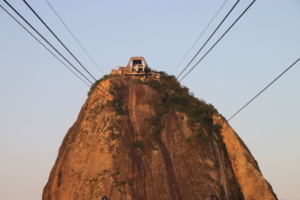
The 1,300-foot Sugarloaf Mountain, seen from a moving cable car.
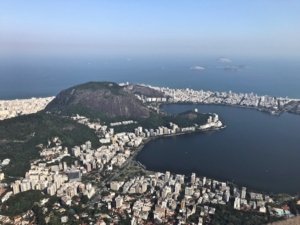
Above, a grand view of Rio de Janeiro from Corcovado and, below, another such view but one that provides a good look at Sugarloaf.
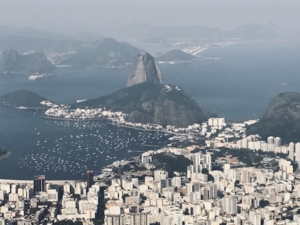
Second, a photo op at the 215-step Selaron Staircase covered in bright tiles and flanked by old bathtubs, which are also covered in tiles, for a vivid mosaic and vivid memories.
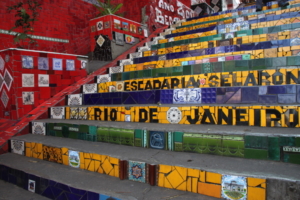
Part of the 215-step Selaron Staircase. The stairs are flanked by an army of bathtubs, including the two visible but not particularly recognizable in this photo. The tubs, like the stairs, are covered with tiles, and visitors are often sitting on them.
Third, a tour of the Maracana soccer stadium, site of World Cup and Olympics events, which Rio tourism hosts like to recommend for fans (that excludes me). A hotel concierge can arrange game tickets — when there are games, of course.
Fourth, two fascinating lunch sites:
The 126-year-old Confeitaria Colombo, an elegant two-story downtown “cafeteria” with lots of woodwork, glass cabinetry, pastries and other takeaways, buffet service for sitdown meals and an atrium good for viewing large parts of the main floor.
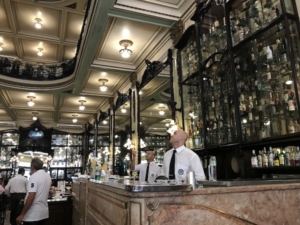
Interior of the elegant 126-year-old Confeitaria Colombo.
The Churrascaria Palace, just off Copacabana Beach, named for its house specialty, churrasco-style cooking (barbecued meats). There was tons of food on buffet tables, but the meat was served according to a local tradition, meaning roving waiters served the meats from skewers directly onto our plates.
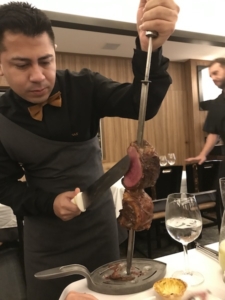
A waiter serves barbecued meat at the table for guests at the Churrascaria Palace.
Security
My local guide was alarmed to watch me carrying a large camera and urged me to keep it out of sight as we roamed streets in the middle of the city. So I asked what she tells visitors about safety. She said:
- Leave passports, most money and all but one credit card in the hotel room safe.
- Don’t wear or carry big brand goods, and don’t wear jewelry that gets attention, especially necklaces.
- Don’t carry big cameras unless with a group. Possessions are safer if one walks around in a group.
- Also, talk to the hotel concierge. Learn when to go where. Be sensible.
Throughout the above, I have talked about a pre-Covid trip. I wouldn’t recommend long-haul flights to anywhere just now, and I don’t know how many of the above options are available in Rio currently anyway.
For more information about Rio de Janeiro, we offer at BestTripChoices.com the following, under the headline, Where samba and soccer meet, at https://besttripchoices.com/rio-de-janeiro-brazil/
This blog and its photos are by Nadine Godwin, BestTripChoices.com editorial director and contributor to the trade newspaper, Travel Weekly. She also is the author of “Travia: The Ultimate Book of Travel Trivia.”
Postscript: Below are two of my photos, taken in Papua New Guinea (1971) and Thailand (1991). Prints of both photos hang on my walls. So, of course, I should recognize two of the faces in the “Ethnicities” collection.

Two Papua New Guinea men seen at a sing-sing in a small village in the country’s highlands. A sing-sing is a gathering of two or more tribes or villages to show off dancing, singing and other traditions to one another. I arrived in this village outside of Kundiawa with a delivery of bread, unaware there was a sing-sing in the offing.

A young Karen woman seen in a refugee camp outside Mae Hong Son, Thailand, near the Thai-Burmese border.
